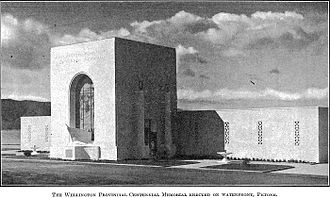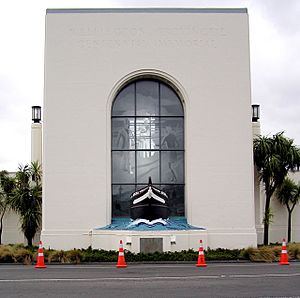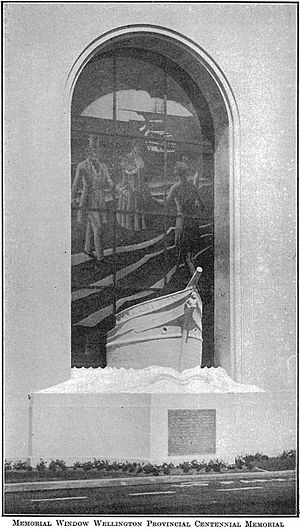Petone Settlers Museum facts for kids
Quick facts for kids Wellington Provincial Centennial Memorial |
|
|---|---|

Wellington Provincial Centennial Memorial c.1940
|
|
| General information | |
| Type | Memorial |
| Architectural style | Art Deco Stripped Classicism |
| Location | The Esplanade, Petone, Lower Hutt, New Zealand |
| Current tenants | Petone Settlers Museum |
| Completed | 1939 |
| Owner | Hutt City Council |
| Design and construction | |
| Architect | Horace L. Massey |
| Awards and prizes | NZIA Gold Medal 1940 |
| Designated: | 6 September 1984 |
| Reference #: | 206 |
The Petone Settlers Museum is a cool place to learn about history! It's located in a special old building called the Wellington Provincial Centennial Memorial in Petone, Lower Hutt, New Zealand. This building was built to celebrate 100 years since the Wellington area was settled. The museum itself opened in 1977, and the building got a big makeover in 2016 to make it look new again. It's so important that Heritage New Zealand calls it a 'Category 1 historic building', which means it's super special!
Contents
The Special Spot
The Wellington Provincial Centennial Memorial building stands right on the Petone foreshore. Petone was originally called 'Pito-one' by Māori, meaning 'end of the sandy beach'. This spot is important because it's where local Māori welcomed the first ship carrying British settlers to Wellington on January 22, 1840. The building is very close to the exact spot where this happened.
Local Te Āti Awa chiefs, like Te Puni and Te Wharepōuri, sold parts of the land around Wellington harbour to the New Zealand Company. This was to provide land for the new settlers. The first settlement was built near Te Puni's village (pā) in Petone.
The Building's Story
Why it was Built
In the mid-1930s, New Zealand's government, led by the Labour Party, started planning big celebrations. These were to mark 100 years since the Treaty of Waitangi was signed. The main event was the New Zealand Centennial Exhibition in Rongotai, Wellington. But money was also set aside for special memorials and events in different regions. One of these was the Wellington Provincial Centennial Memorial on the Petone foreshore.
Designing the Memorial
A national competition was held to find the best design for the building. A famous Wellington architect named William Gray Young was the judge. The winner was Horace Lovell Massey, an architect from Auckland. Massey even won the NZIA Gold Medal for his design. A historian named Gavin McLean said the building was 'Wellington's provincial memorial but in many ways the New Zealand monument to pioneer endeavour'. He also called it 'an enduring celebration of pioneering'.
What the Building Looks Like
The memorial's design mixes two styles: Stripped Classicism and Art Deco. Inside, there's a main 'Hall of Memories'. On either side, there were originally two rooms that were changing rooms for people swimming at the beach. This is because the building was also a bathing pavilion!
The building has some cool features. There's a large glass window with designs etched into it. There's also a stone copy of the front part (prow) of the ship Aurora. This was the first ship that brought New Zealand Company settlers to Wellington. This stone prow faces the street at the bottom of the window.
On December 18, 1938, Ivor Te Puni, a descendant of Chief Te Puni, wrote to the Prime Minister. He asked that the Māori people, who welcomed the settlers 100 years ago, also be remembered. Because of his letter, the etched glass window shows Te Puni reaching out his hand in welcome. He is greeting the new settlers, who are shown as a man in a suit and a woman holding a child.
The memorial was officially opened on January 22, 1940. The ceremony was led by Prime Minister Peter Fraser and Governor-General Lord Galway.
The Petone Settlers Museum Today
From Bathing Pavilion to Museum
Over time, swimming at Petone beach became less popular. This was because of waste from a large meat factory nearby called the Gear Meat Factory. So, the bathing pavilions started to fall apart.
In 1977, the western bathing pavilion was turned into the Petone Settlers Museum. Two years later, the museum grew and took over the eastern bathing pavilion too.
Today, the museum is a place where you can find lots of information and objects. These tell the story of Māori and Pakeha settlement in the area. You can also learn about the social life, culture, sports, and industries of Petone.
Recent Makeover
In 2016, the museum building had a big refurbishment, costing $250,000. This makeover aimed to bring back the building's original look and feel. Things like decorative concrete grills were put back, and the building was painted its original colour. The original opening at the back, which faced the beach, was given new glass. Also, coloured paint that had been put on the ship prow and other sculptures outside was removed. They were returned to their original cream colour, just as they were when first built.
During the work, builders found the original tiled foot baths! Swimmers used to walk through these baths to get to the changing rooms. The museum reopened on May 29, 2016, with a fun family open day to celebrate the new look. Another $75,000 was spent on making the exhibition spaces inside the museum fresh and exciting.



